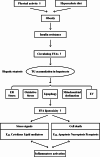Updated mechanisms of MASLD pathogenesis
- PMID: 38649999
- PMCID: PMC11034170
- DOI: 10.1186/s12944-024-02108-x
Updated mechanisms of MASLD pathogenesis
Abstract
Metabolic dysfunction-associated steatotic liver disease (MASLD) has garnered considerable attention globally. Changing lifestyles, over-nutrition, and physical inactivity have promoted its development. MASLD is typically accompanied by obesity and is strongly linked to metabolic syndromes. Given that MASLD prevalence is on the rise, there is an urgent need to elucidate its pathogenesis. Hepatic lipid accumulation generally triggers lipotoxicity and induces MASLD or progress to metabolic dysfunction-associated steatohepatitis (MASH) by mediating endoplasmic reticulum stress, oxidative stress, organelle dysfunction, and ferroptosis. Recently, significant attention has been directed towards exploring the role of gut microbial dysbiosis in the development of MASLD, offering a novel therapeutic target for MASLD. Considering that there are no recognized pharmacological therapies due to the diversity of mechanisms involved in MASLD and the difficulty associated with undertaking clinical trials, potential targets in MASLD remain elusive. Thus, this article aimed to summarize and evaluate the prominent roles of lipotoxicity, ferroptosis, and gut microbes in the development of MASLD and the mechanisms underlying their effects. Furthermore, existing advances and challenges in the treatment of MASLD were outlined.
Keywords: Lipid metabolism; Lipotoxicity; MASLD; Therapeutics.
© 2024. The Author(s).
Conflict of interest statement
The authors declare no competing interests.
Figures




Similar articles
-
Pharmacological treatment for metabolic dysfunction-associated steatotic liver disease and related disorders: Current and emerging therapeutic options.Pharmacol Rev. 2025 Mar;77(2):100018. doi: 10.1016/j.pharmr.2024.100018. Epub 2024 Nov 22. Pharmacol Rev. 2025. PMID: 40148030 Review.
-
Lipotoxicity-driven metabolic dysfunction-associated steatotic liver disease (MASLD).Atherosclerosis. 2025 Jan;400:119053. doi: 10.1016/j.atherosclerosis.2024.119053. Epub 2024 Nov 14. Atherosclerosis. 2025. PMID: 39581063 Review.
-
Therapeutic implications for sphingolipid metabolism in metabolic dysfunction-associated steatohepatitis.Front Endocrinol (Lausanne). 2024 Jun 19;15:1400961. doi: 10.3389/fendo.2024.1400961. eCollection 2024. Front Endocrinol (Lausanne). 2024. PMID: 38962680 Free PMC article. Review.
-
Advances in the acting mechanism and treatment of gut microbiota in metabolic dysfunction-associated steatotic liver disease.Gut Microbes. 2025 Dec;17(1):2500099. doi: 10.1080/19490976.2025.2500099. Epub 2025 May 20. Gut Microbes. 2025. PMID: 40394806 Free PMC article. Review.
-
A read-through circular RNA RCRIN inhibits metabolic dysfunction-associated steatotic liver disease.J Hepatol. 2025 Jun;82(6):1068-1079. doi: 10.1016/j.jhep.2024.11.052. Epub 2024 Dec 10. J Hepatol. 2025. PMID: 39667599
Cited by
-
Common Denominator of MASLD and Some Non-Communicable Diseases.Curr Issues Mol Biol. 2024 Jun 29;46(7):6690-6709. doi: 10.3390/cimb46070399. Curr Issues Mol Biol. 2024. PMID: 39057041 Free PMC article. Review.
-
Association of pan-immune-inflammatory value with metabolic dysfunction-associated steatotic liver disease: findings from NHANES 2017-2020.BMC Gastroenterol. 2025 Jan 3;25(1):4. doi: 10.1186/s12876-024-03584-2. BMC Gastroenterol. 2025. PMID: 39754093 Free PMC article.
-
Overview of the hazardous impacts of metabolism-disrupting chemicals on the progression of fatty liver diseases.Mol Cell Toxicol. 2025;21(2):387-397. doi: 10.1007/s13273-025-00521-6. Epub 2025 Feb 27. Mol Cell Toxicol. 2025. PMID: 40160987 Free PMC article.
-
MetALD: New Perspectives on an Old Overlooked Disease.Liver Int. 2025 May;45(5):e70017. doi: 10.1111/liv.70017. Liver Int. 2025. PMID: 40179033 Free PMC article. Review.
-
Management of metabolic dysfunction-associated steatotic liver disease (MASLD)-An expert consensus statement from Indian diabetologists' perspective.Diabetes Obes Metab. 2025 Jun;27 Suppl 4(Suppl 4):3-20. doi: 10.1111/dom.16496. Epub 2025 Jun 2. Diabetes Obes Metab. 2025. PMID: 40457532 Free PMC article. Review.
References
Publication types
MeSH terms
Grants and funding
LinkOut - more resources
Full Text Sources

